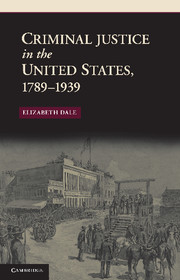Book contents
- Frontmatter
- Contents
- Introduction
- 1 criminal justice and the nation, 1789–1860
- 2 crime and justice in the states, 1789–1839
- 3 law versus justice in the states, 1840–1865
- 4 states and nation, 1860–1900
- 5 criminal justice, 1900–1936
- 6 rights and the turn to law, 1937–1939
- Conclusion
- Bibliographic Essay
- Index
- References
6 - rights and the turn to law, 1937–1939
Published online by Cambridge University Press: 05 June 2012
- Frontmatter
- Contents
- Introduction
- 1 criminal justice and the nation, 1789–1860
- 2 crime and justice in the states, 1789–1839
- 3 law versus justice in the states, 1840–1865
- 4 states and nation, 1860–1900
- 5 criminal justice, 1900–1936
- 6 rights and the turn to law, 1937–1939
- Conclusion
- Bibliographic Essay
- Index
- References
Summary
Advocates of the rule of law had triumphed over proponents of lynching, but in other respects the constitutional order appeared to have broken down by the mid-1930s. Although the Supreme Court had taken steps to check mobs’ ability to control the criminal courts, those decisions applied to only the most extreme cases. The rest of the time, due process, although valued – at least in the abstract – in the federal courts, was hardly a guarantee in state court criminal trials. Police departments, though stronger and marginally more professional than in the past, remained susceptible to corruption and public pressure and far too inclined to abuse their power. The forces of popular justice were often prejudiced against outsiders and easily manipulated. But then, in 1937, the Supreme Court suggested that it was willing to shift the constitutional order to bring those problems under control. Taking a leaf from the efforts to eradicate lynching, the Court approved congressional efforts to move disputes out of the streets and into the courts. At the same time, it altered its own view of rights, suggesting the possibility that it would be more receptive to efforts by state court criminal defendants and outsiders to use claims of rights.
- Type
- Chapter
- Information
- Criminal Justice in the United States, 1789–1939 , pp. 122 - 135Publisher: Cambridge University PressPrint publication year: 2011

